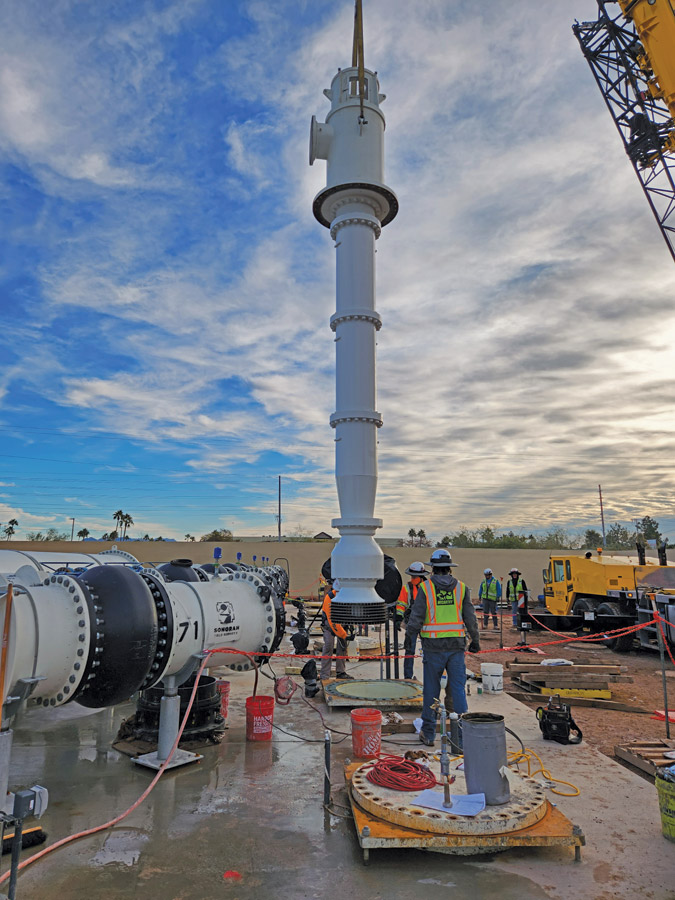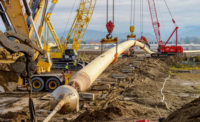2024 Southwest Best Projects
Best Water — Phoenix Water Drought Pipeline Program

Photo courtesy Carollo Engineers
Phoenix Water Drought Pipeline Program
Phoenix
BEST PROJECT
Submitted by: Brown and Caldwell
Owner: City of Phoenix
Lead Design Firm: Brown and Caldwell
Consulting Engineers: Black & Veatch; Carollo Engineers; Entellus; Stanley Consultants
CMARs: Kiewit Infrastructure West Co.; McCarthy Building Cos.; PCL Construction; Sundt Construction
Public Outreach Consultant: Central Creative
In 2018, as part of continuing efforts to diversify its water supply and plan for the future, the city of Phoenix initiated the $250-million Drought Pipeline Program. Scope included the design and construction of two 90-million-gallon-a-day booster pump stations (BPS), two pressure-reducing valve (PRV) stations and more than nine miles of 66-in. pipeline. Work was spread across four packages, each one assigned an engineering consultant and a construction manager at-risk.
The city’s main program goals were ensuring customers in north Phoenix would continue to have water service if there were restrictions on the Colorado River as well as providing operations staff with flexibility and redundancy within the Phoenix water system.
The entire team of engineers, consultants, CMARs and city staff collaborated across all four projects. But there were some schedule setbacks due to supply chain issues and labor shortages when construction started in 2021.

Photo courtesy Entellus
These four projects and their scopes included: Segment 1, a 66-in.-dia welded steel water transmission pipeline from the 24th Street WTP to Shea Boulevard/32nd Street; Segment 2, a 66-in.-dia welded steel water transmission pipeline from Shea Boulevard/32nd Street to Bell Road/32nd Street; Package 1, a BPS 4A-B10 (76 mgd capacity with future 90 mgd) and 60 mgd PRV 1-R8 at 24th Street Water Treatment Plant; and Package 4, BPS 4A-B11 (75 mgd capacity with future 90 mgd) at 31st Street and Bell Road.
Segment 2’s team developed a way to take control of backfill material production by utilizing two volumetric mixer trucks to produce more than 42,000 cu yd of controlled low strength material. This process allowed the team to quickly backfill deep trenches to minimize safety hazards to the traveling public and speed access to neighboring businesses.
This solution helped solve issues related to placing concrete orders three to four weeks ahead of time, which often were canceled when suppliers were unable to fill orders or concrete was being rationed to each contractor. The volumetric mixer trucks produced CLSM and concrete in “as-needed” batches and therefore eliminated material waste that is commonly seen when ordering ready-mix material.

Photo courtesy Black & Veatch
On Segment 1, a 1,500-ft-high pressure portion of the pipeline is located in a narrow corridor between residences and a large freeway sound wall. The team designed and installed a one-of-a-kind pipeline leak detection system including a drainage sheet along the pipeline haunch and horizontal drainage collection lines, spaced at 250-ft intervals, connected to vertical water detection wells extending to the surface. The system is encased in concrete up to a foot above the pipeline. This system will allow the city to proactively detect and locate small leaks in an area with extremely high consequences of failure.
Since the pipeline and pump stations provide redundancy, full-scale system testing required existing water treatment plants and other facilities to significantly reduce their capacity or shut down during non-optimal times of year. Coordination and planning were completed with the four project teams and city operational staff to identify various operating scenarios to test, develop detailed risk registers for the scenarios and put protective measures in place.



